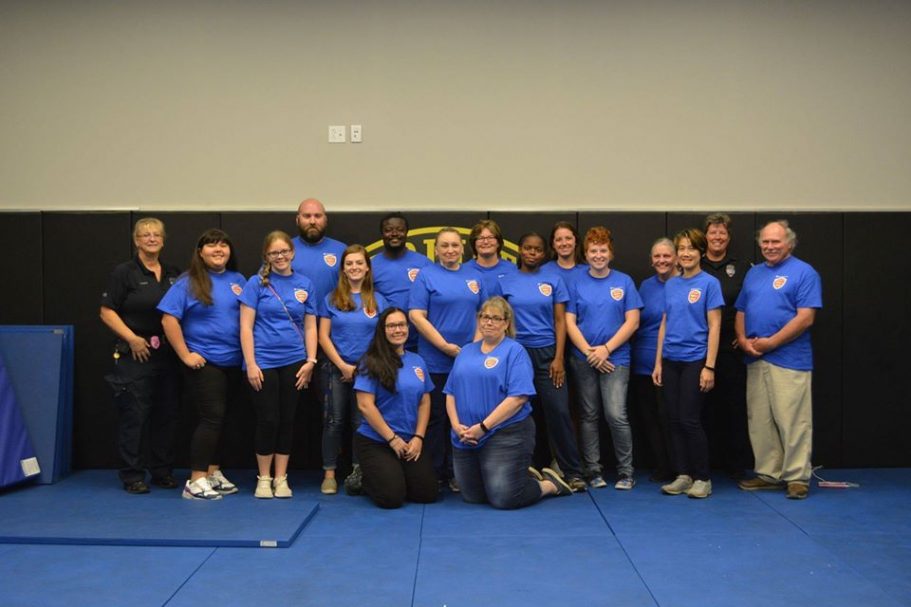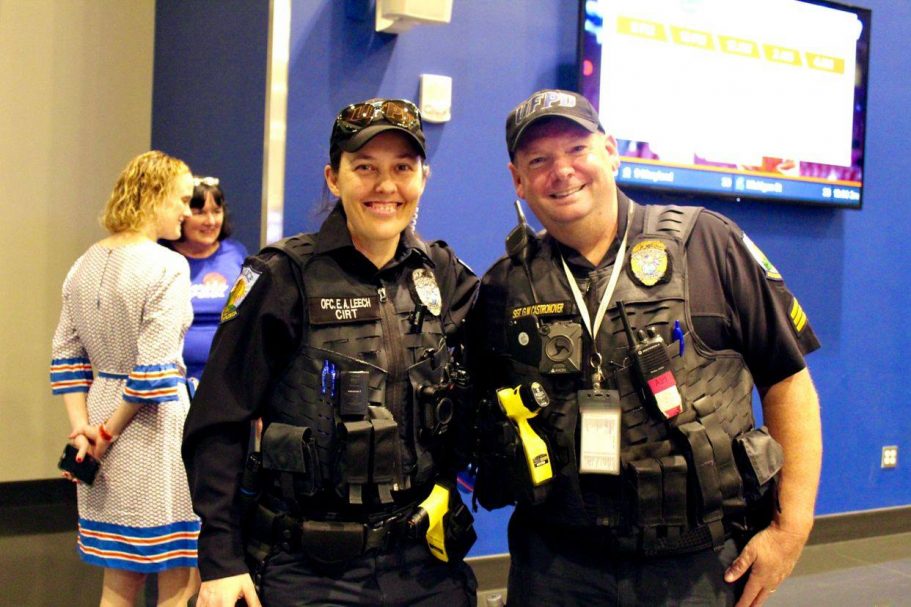- Homepage
- Community Programs
- Videos
- Shots Fired
Shots Fired
Text Transcript Below
I’m Randy Spivey… And I’m Jim Sporleder, both from the Center for Personal Protection and Safety….
Even though the possibility of being involved in an Active Shooter situation is very remote, the consequences are potentially catastrophic. That’s why it makes good sense for you to spend some time thinking and preparing for it.
On any given day, chances are lightening will strike someone, somewhere and during any given month or year, the reality is an active shooter will strike somewhere in a workplace. If that someplace is your workplace, you’ll need the proper mindset and the tools necessary to react with purpose and to maximize your chance of survival. If lightning does strike, if an active shooter does enter your workplace, history tells us the incident is often over before any law enforcement or response teams can arrive on scene. Workplace shootings can occur anytime, anywhere and to anyone. The simple fact is they happen to folks just like you. And let’s be candid, if lightning does strike, if an active shooter enters your workplace, it will be unlike any situation you’ve ever experienced. And in those initial heat-stopping moments, it will only involve you, your colleagues and the shooter. The bottom line is you’ll need to take direct responsibility for your personal safety and security. You MUST develop a survival mindset.
“Survivors are committed to doing whatever it takes, they’ve taken the time to ask themselves “What would I do if…” We call those what-if questions. And they prepare themselves both mentally and emotionally, to survive the outcome. In other words they become stakeholders in their own safety and security.”
“In studies of workplace and also school shootings we know that many of these incidents are over in a very short period of time: 10-15 minutes. You often won’t be the first line of defense in dealing with these particular issues.”
Your survival mindset is like a protective shield comprised of Awareness, Preparation, and Rehearsal. Awareness involves taking the time necessary to gain a basic understanding of an active shooter situation. Preparation is asking yourself the “what-if” questions that will enable you to develop effective response strategies. The last component, Rehearsal, is practicing your plan.
Shots fired! Do you know what that sounds like? Unless you see the shooter, you may not recognize the sounds for what they are–gunshots. For most of us, our experience with gunshots is drawn from movies and television that use special sound effects. That means real gunshots can sound artificial. You could lose precious seconds as you slowly realize that these are, in fact, life-threatening sounds.
“Well in many reports of workplace shootings, it’s not unusual for individuals to have admitted or said that when they first heard the sounds would appear to be gunshots. They thought they were something other than that”
“If you hear some popping noises, don’t be standing there thinking, ‘well I wonder what that is’. Evacuate immediately. Nearest door, nearest window. Get out of the building. If it turns out it wasn’t shooting, it was a car backfiring or something—big deal.
Those are gunshots. So what should you do in those precious, first seconds? You’ll need to figure out what’s going on and make immediate decisions. How are you going to survive this situation? Will you get out? Is there a path of escape? Will you hide out? Is there a chance to get to where the shooter might not find you? Or will you find yourself in a situation where the only option is to try to take out the shooter in whatever way you can?
These are serious decisions. That’s why the survival mindset is so important to develop. Research shows that there’s a real difference between the reactions of people who’ve been trained to face stressful, life-threatening situations and those who have not. The first response is the same in both groups: Startle and Fear. But the reactions between the two begin to differ immediately after that. People who have gone through training, people like you, feel anxious, where the untrained and unprepared begin to feel panic. Trained people begin to recall what they’ve learned, the untrained fall into disbelief.
“I can’t believe this is happening.” At this point, the divide between the two starts to get wider.
While the untrained are lost in Denial: “this can’t be happening to me,” the trained people are preparing to act just as they’ve rehearsed. “We’ve got to get out of here!” Finally, as the untrained descend into helplessness, the trained commit to action based on a survival mindset.
A survival mindset enables you to act quickly and effectively. Let’s go back to the foundation: awareness. When you get on a plane and the crew asks you to note the nearest exit, they’re not trying to create fear; they’re certainly not trying to make you afraid to fly, they’re just trying to make you aware, providing information so you can develop the survival mindset for that situation. They know that if there is an emergency, getting you in a pre-determined mindset will help you take rapid, effective actions in a stressful situation. They want you to be mindful, not fearful. If you’re mindful, you’ll be better able to make that first critical decision. Take a tip from the airlines. Like noting the emergency exits, it may only take a minute or two to look around your environment and make some mental notes about how you’d handle an active shooter situation.
Look at your work environment through the lens of survival. ‘How will I survive an incident if it happens in my workplace? What should I do?” What will I do? What are my possibilities?’ These are good questions to ask.
You have to realize what the issues may be, ask the what-if questions and plan your strategy for action should this incident ever occur.
So first, figure out the situation– what’s going on? Where’s it happening and who’s doing it? Build your awareness using all your senses…and do it quickly. Trust your intuition, your “gut feeling.” It’s a built-in survival mechanism. Some people say it’s “knowing without knowing why,” and it’s an invaluable tool. For example, if you hear something that sounds like it might be a gunshot, assume that it is until you know otherwise. Once you figure out what is going on, you’ll be better prepared to take action.
If you determine that you can GET OUT to a safer area, then get out…and get out fast. Don’t wait for others to validate your decision. And leave your belongings behind. The best way to survive an active shooter situation is NOT to be where he is…and NOT to GO where he can see you.
When you get out, immediately CALL OUT to let authorities know what’s going on. DO NOT ASSUME someone else is calling.
Call 911 and be ready to give them useful information– and be persistent, as the phone lines may be jammed with other calls. Calmly and quickly tell them where you are and what’s happening.
In some cases, you may not be able to get out. The shooter may be between you and the only exit, or perhaps you would have to enter the area or the hallway the shooter is using. It might be safer for you to remain in place because you’re well-hidden and well protected. In any case, if you can’t get out, then you MUST find a place to HIDE OUT. Find a place that will keep you hidden from the shooter’s view and will provide some measure of protection should the shooter fire in your direction. If possible, avoid places that might trap you or restrict your options of movement. Once you’ve found your spot to hide out, you’ll want to KEEP OUT the shooter. Hiding in a room that can be locked and that has plenty of things to hide behind is best. Blockade the door with heavy furniture (even if the door can be locked). If the shooter is nearby, though, just lock the door and get totally silent. Turn off any radios or other noises in the room that might alert the shooter to your presence… and don’t forget to silence that cell phone or pager if you have one. As soon as you have an opportunity, and without attracting the shooter’s attention, call out to 911.
If there are two or more of you in the same place, do NOT huddle together for mutual protection or moral support. SPREAD OUT! It’s much easier for someone to shoot a group of people who are huddled in one place than if they are scattered around the room. Even if you’re in a small room, spreading out will give you options and make it harder for the shooter if he does get into your hiding place. When spreading out in a room, quietly talk about what you’ll do if the shooter enters. Whichever action you’re taking– whether it’s get out or hide out and keep out–you should help out where you can.
Help others escape as you go. Help prevent others from entering the danger area. If someone near you has a life-threatening injury, if possible, provide first-aid and keep them alive. Let others around you know what’s happening and try to maintain calm and help them focus on survival. Keep in mind, as events unfold, you must continue to FIGURE OUT what’s happening so you can adjust your actions accordingly.
Unfortunately, you may find yourself in the same room as the shooter, maybe even face-to-face. You have to assume that his intentions are lethal to you… that his presence is a very real threat to your life. If a shooter has decided to shoot everyone he comes across, he’ll probably succeed, unless YOU stop him.
If you can’t hide out, and you have absolutely no other option, you may have to confront your assailant. Convince yourself that you have what it takes to survive when your life is on the line. This is a life and death decision only you can make. It’s so important to understand that in this kind of situation, anything you do, or anything you don’t do, may involve life-threatening risk. If you determine there’s no other option than to TAKE OUT the shooter, then you must be prepared to do whatever is necessary to neutralize the threat.
“Get ready to react. Don’t everybody sit on the floor and cower like sheep and let some guy walk around and start killing you.”
To do this, you’ll need to become more aggressive than you ever thought possible. This means you either disrupt his actions or incapacitate him. Throwing things, yelling, using improvised weapons can all be effective in this situation, but total commitment and absolute resolve are critical.
“Hey, it’s you or him. So react. If he comes into the room and you’ve got nowhere to go, there’s 20 of you, go at him. Take him. Do the best you can.”
“You’re going to have to be as aggressive as you possibly can, for as long as its going to take to once again, neutralize that threat and to ensure your safety and security.”
If there are two or more of you, spread out, make a plan, and act as a team to overcome the shooter. Once again, you and the group will have to make a total commitment to your action and do absolutely whatever it takes without hesitation. To understand this better, think of the terrorist attacks on 9/11. Up until that day, the conventional wisdom about plane hijackings was that you should be calm, non-threatening, and wait for the plane to arrive at the hijacker’s destination. Obviously, that guidance didn’t apply to the hijackings that day. In fact, the passengers of United Flight 93 realized this and used a process like we’re describing in this program to figure out what was happening. Once they FIGURED OUT that the purpose of the hijacking was to kill as many people as possible, the passengers took decisive action to neutralize the threat and prevent further loss of life.
The people that I’ve spoken to over the years who have survived critical incidents shared that common single mindedness trait of they were going to make it through the situation no matter what it took. Even if they were physically injured, they weren’t going to just throw their hands up and quit. They were going o keep going for as long as they could.
There is another possible resolution to an active shooter situation, and that’s when Law Enforcement arrives and takes action to end the shooting. When officers arrive, be prepared to calmly, quickly, and accurately tell them what they need to know: Location of the shooter; number of the shooters, if there’s more than one; description of the shooter; and number and kind of weapons they have.
“The people that I’ve spoken to over the years who have survived critical incidents, ah… shared that common single mindedness trait of… they were going to make it through this situation no matter what it took, even if they were physically injured, ah… they weren’t going to just through their hands up and quit. They were going to keep going for as long as they could.”
There is another possible resolution to an active shooter situation, and that’s when Law Enforcement arrives and takes action to end the shooting. When officers arrive, be prepared to calmly, quickly, and accurately tell them what they need to know: location of the shooter; number of shooters, if there’s more than one; description of shooter; and number and kinds of weapons they have.
Do NOT expect officers to assist you as you get out. Their first job is to stop the shooter and end the bloodshed. First responders are trained to go to the sounds of the gunshots and eliminate the threat. If you’re in a room and an emergency response team comes in, you MUST NOT PRESENT A THREAT TO THEM. Do not point at them or the shooter. Do NOT scream or yell. Be quiet and compliant. Do exactly as they say. Remember, they have no way of knowing immediately whether you’re one of the good guys.
Police department, show me your hands! The officers have been taught that “hands kill” and they’re trained to first look at people’s hands. So raise your arms, spread your fingers and show them your hands as you drop to the floor.
“When we make entry into a business, if we have an active shooter, we may not know who the active shooter is, we don’t know who you are. So if we come into a room, no quick movements, have your hands up in the air, don’t have anything in your hands.”
They’ll know immediately that you’re not armed or aggressive. That will help them focus on anyone who is armed and prevent them from mistaking you for the “bad guy” in a very dangerous situation. Remember, they have to begin by assuming everyone is a threat.
“Don’t make any quick movements towards us at any time. Don’t try to hug us. Don’t ry to grab us. You know were in this environment to try to find the person who’s doing the shooting, so do exactly what we tell you to do and everything will be fine.”
It’s important for you to realize there are differences between an active shooter and a hostage-taking situation. The hostage taker wants to use people as leverage to achieve a goal. This is very different than an active shooter, who is there to take lives. If you find yourself in a hostage situation, remain calm, follow directions and wait for the authorities to resolve the situation.
In most instances the best course of action for someone finding themselves in that situation is to maintain their composure and be compliant and be patient.
Historically, the vast majority of hostage situations are resolved through negotiations and they end peacefully. But, if the situation changes and someone is actually walking around with a gun shooting people, you’re in an active shooter situation.
The focus of this program has been on surviving an active shooter situation. However the most effective ways of dealing with this difficult problem is through effective prevention programs. Interestingly, the same survival mindset we’ve been talking about today can sometimes prevent a situation from becoming violent in the first place. There may be warning signs or pre-incident indicators that something is wrong.
We do see pre-incident indicators; we do see some behaviors that might suggest the possibility of eventual violence. And many of these workplace offenders oftentimes exhibit angry or argumentative behavior. They often blame others for their problems. They fail to take responsibility for their own actions. They’re what we would call injustice collectors. They perceive every slight as a major issue that they have to take action upon.
If you’re suspicious about something or you really have an uncomfortable feeling, far better to report those types of observations and feelings than to just disregard them and hope that they’re going to go away.
Hopefully, your company already has a workplace violence program in place that provides specific guidance on how to maintain a workplace free from threats and violence.
“Well, certainly one of the major prevention issues when you look at workplace violence is creating an environment in the workplace where people are treated with dignity and respect.”
Take the time to listen to other people. Many times individuals that get involved in violent encounters are individuals that are very frustrated because no one has taken the time, from their perception, to listen to them.
Remember: it’s everyone’s responsibility to keep the workplace safe.
Shots fired … a sound you hope to never hear… But if lightning does strike, you’ll always have a weapon–a survival mindset. You can survive.





